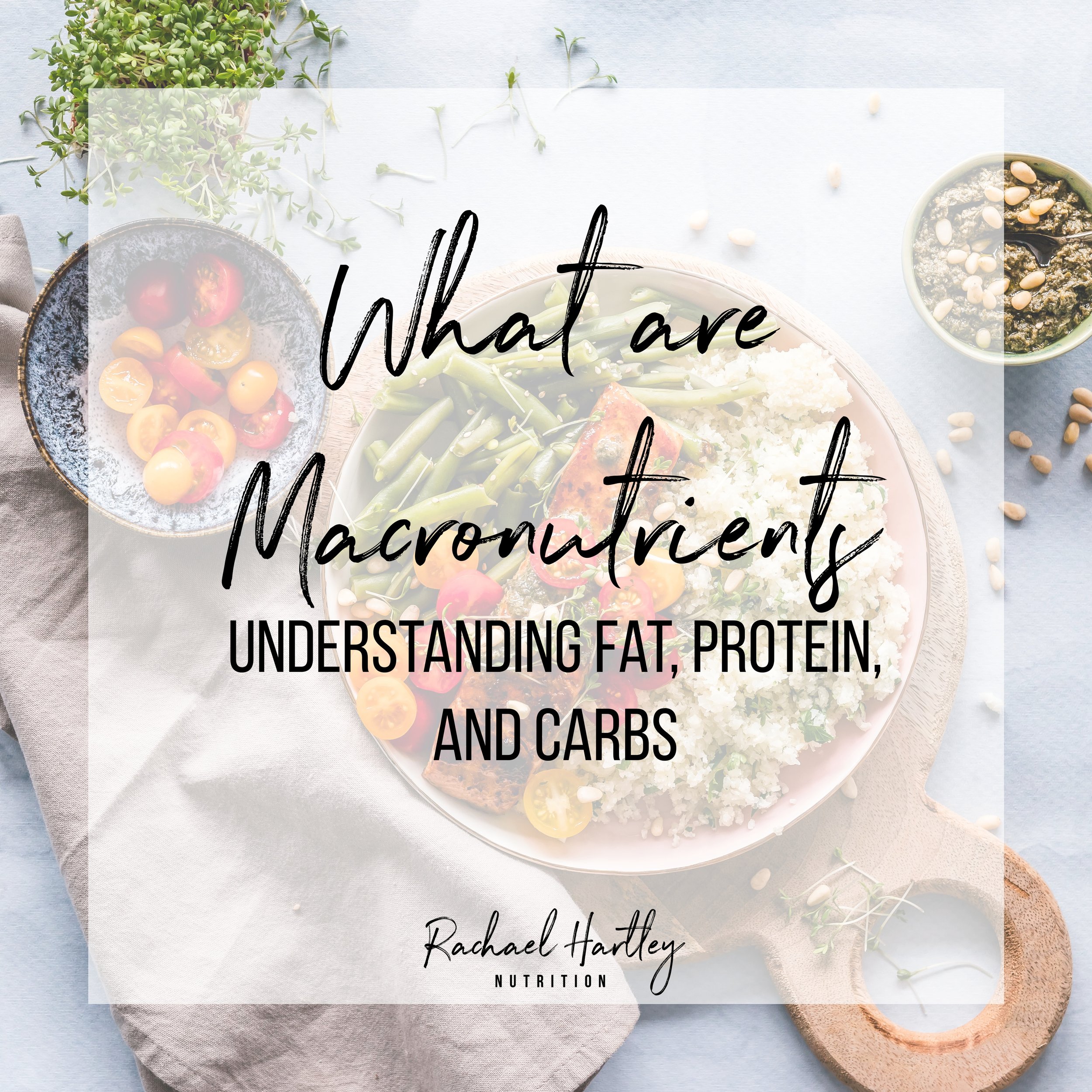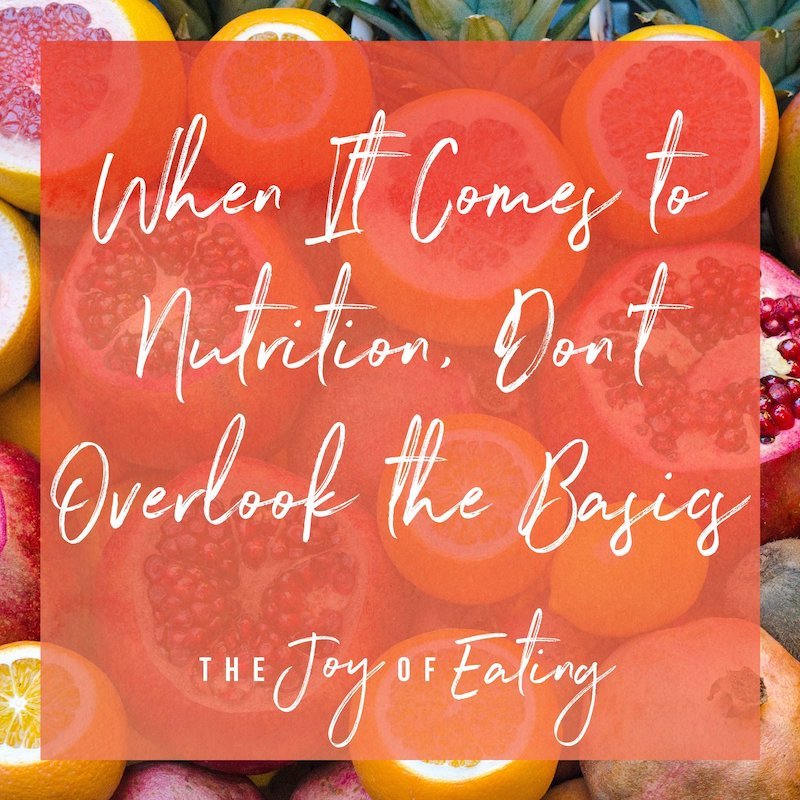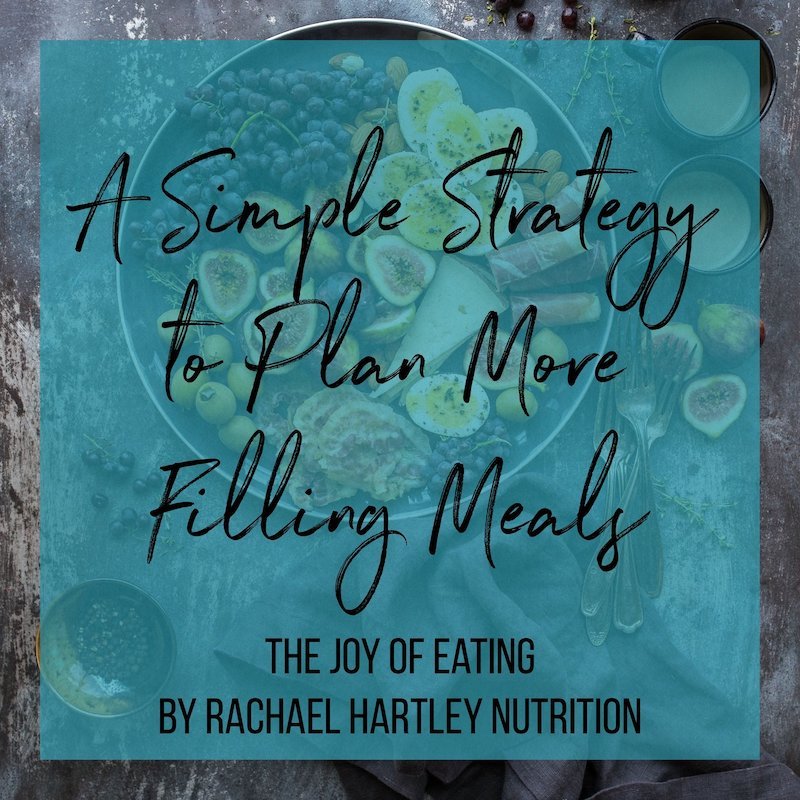What Are Macronutrients: Understanding Carbs, Fat and Protein
With the popularity of macro counting, people are more aware than ever of what macronutrients are, yet there is still a lot of misunderstanding about carbs, fat and protein that can make eating stressful. This post answers the question “what are macronutrients” and will hopefully help you feel less stressed knowing how to feed yourself!
In my practice, we focus on food over nutrients. That’s because as humans, we consume food - not vessels for carbs, fat, and protein.
Looking at mainstream nutrition discourse, there’s an obsessive focus on macronutrients (and micronutrients), and food, eating patterns, and one’s experiences and relationship with food are overlooked. This approach to nutrition is called nutritionism, a reductionist way of looking at food and evaluating its nutritional value based on the sum of its individual nutrients. This fixation on nutrients guides much of nutrition research, and the popular view of what “healthy” eating looks like.
That said, because there is so much misunderstanding about macronutrients, I think some basic understanding of them can be really helpful in making food and eating decisions. I hope that in helping you answer the question of “what are macronutrients,” and debunking or reframing what you’ve been taught about them, you feel more confident in your food choices.
This stir fry has a balance of nutrients, quinoa for carbs (and protein), tofu for protein, and fat from the sesame oil the veggies and tofu were fried in.
What Are Macronutrients?
Macronutrients are nutrients in food that break down to provide your body with energy (aka calories). The three macronutrients in food are carbs, fat, and protein. Technically, alcohol is also a macronutrient as it provides the body with energy, but for obvious reasons that’s not included in the three principle macronutrients, and we won’t discuss it in this post :)
Humans don’t photosynthesize. We don’t fill up our tank with gasoline or plug into batteries. We eat food, and that’s how our body obtains energy to breathe, walk, talk, think, and do all our daily activities. Macronutrients are the compounds that provide your body with energy. They break down into smaller units that are absorbed into the bloodstream during digestion, and eventually distributed to cells so they can do their thing.
The term "macro" means large, meaning these nutrients are needed in large amounts, and that they are larger chemical compounds. This is opposed to micronutrients, like vitamins and minerals, which are also important, but needed in smaller amounts for human functioning. Also, while micronutrients are needed in various metabolic reactions to convert macronutrients to energy, and in other bodily processes, they do not break down to provide the body with energy.
What are Macronutrients: Carbohydrates
Carbohydrates are the body’s main source of fuel. They break down into monosaccharides - simple sugars that include glucose, fructose, and galactose (although often these are grouped together and referred to as glucose). There are three main types of carbohydrates found in food: sugars, starches and fiber. Most carbohydrate containing foods will have a combination of these three. I’ll also note, fiber is a type of carbohydrate that does not break down to provide the body with energy, but it does play other important roles, including aiding digestion, supporting healthy blood sugar levels, and promoting satiety.
Carbohydrates are the body’s main source of fuel, including the only source of fuel your brain can use. Technically, your body has a backup fuel source through ketosis, which produces energy your brain can use in the absence of adequate carbohydrate. A good thing because otherwise we would go braindead if you went too long without eating or went on a low carb diet! However, this is a backup system designed to protect you against starvation and death, and has side effects including loss of muscle mass, headache, fatigue, nausea, cramping and funky breath/body odor. Because carbs are so essential, one doesn’t need to go into ketosis to have side effects of inadequate carbohydrate intake. Not eating enough carbs can lead to difficulty concentrating, fatigue, anxiety, mood swings (hello hanger), and extreme hunger as your body signals it’s internal fuel tank is low.
Carbs are found in the following foods*:
Grains - anything made with flour (i.e. bread, pasta, baked goods, tortillas, cereals, crackers, pretzels, etc), rice, quinoa, oats, corn, millet, teff, barley, buckwheat, etc.
Beans and pulses - black beans, chickpeas, lentils, butter beans, pinto beans, etc.
Starchy vegetables - potatoes, sweet potatoes, winter squash, parsnips, etc.
Milk and yogurt
Fruit
Table sugar and other sweeteners (i.e. maple syrup, honey, agave, etc.)
Non-starchy vegetables - non-starchy vegetables like tomatoes, zucchini, lettuces, etc. contain very small amounts of carbohydrate, and mostly fiber, but I’ll include them here
Anchovy pizza was a more carb focussed lunch, but still had some fat and protein from the cheese, spicy oil and anchovies.
What Are Macronutrients: Fat
Fat is the most calorie-rich macronutrient. It breaks down into fatty acids to provide our body with energy. Diet culture says this is a bad thing, but fat provides some major satisfaction factor to meals. Besides being a rich source of energy, fat plays many essential roles in the body. Dietary fat provides the body with essential fatty acids, structural compounds the body cannot make itself and can only obtain through food. Fat is also needed to absorb fat-soluble vitamins, including vitamins A, D, E and K. Fats are needed to create hormones, and also supports healthy skin and hair. They are also essential to brain health, as the brain is composed of 60% fat.
Fats are found in the following foods*:
Oils - olive, canola, sunflower, vegetable, soybean, sesame, peanut, etc
Butter, lard, shortening and margarine
Full fat and 2% (reduced fat) dairy
Eggs
Meat, poultry and some types of fish
Nuts & seeds
Avocado
This caprese-inspired salad didn’t have much carb (so I probably had to follow it up soon after with a snack that did have a carb food!), but it felt super satisfying because it was high in fats from mozzarella, confit tomatoes, almonds, and pesto dressing.
What Are Macronutrients: Protein
Protein breaks down into amino acids. Most people are aware that protein is needed to build muscle, but it has many other functions as well. The amino acids obtained from protein are used in the growth and maintenance of all body tissues, to create enzymes needed in the thousands of different enzymatic reactions that take place in your body, as messengers between cells, and to create hormones.
Protein is found in the following foods*:
Meat and poultry
Fish and seafood
Eggs
Dairy - milk, yogurt, cheese
Beans and pulses - black beans, chickpeas, lentils, butter beans, pinto beans, etc.
Nuts and seeds
Soy products - tofu, tempeh, soybeans
Meat alternatives - Beyond/Impossible Burger, foods made with wheat gluten/seitan, etc
* I’ve listed these foods as the most common sources of the macronutrients, but please note that most foods contain a mixture of macronutrients. For example, milk contains fat, protein and carbohydrate, beans contain protein and carbs and eggs contain protein and fat.
A vegetarian meal that had a nice balance of macronutrients - pan-fried corona beans with potatoes roasted in olive oil, cabbage and onions sauteed in butter, grated cotija cheese and toasted walnuts. Beans are great in that they provide protein and carbs!
How Much Carbs, Fat and Protein Should You Eat?
Thanks to the popularity of IIFYM (If It Fits Your Macros) diets, micromanaging macronutrients has never been easier…and I don’t think that’s a good thing.
The popularity of IIFYM has left an impression that how many macronutrients you need to eat should be closely monitored and balanced. I’ve heard traumatic stories from multiple clients who had spent their Sundays crying through meal planning, desperately trying to figure out what they could make that would fit into their recommended macronutrient ranges.
In reality, here’s the percentage of caloric intake recommended for each of the three macronutrients in the DRIs (Dietary Reference Intake):*
Carbs: 45-65%
Fat: 20-35%
Protein: 10-35%
As you can see, these are pretty wide percentage ranges! When you calculate it into grams and consider individual needs, the gap is even wider. For example, how many carbs someone who is larger and more active should eat compared to someone who is smaller, and less active is a pretty big difference, even if they’re both aiming for 55% of their calories. Then imagine the difference if the first person had a higher carb pattern to fuel their activity and the second ate a lower carb dietary pattern. As you can imagine, it’s pretty challenging to give any kind of precise gram recommendation.
Here's my take: for most people, the majority of your energy intake should come from carbohydrates. It's the body’s main and preferred source of energy. Plus, carbohydrates are extremely common in food, especially the foods we do best eating more of - plants.
That said, beyond that, it’s pretty tough to give precise recommendations. People vary in their health needs, taste and cultural preferences. One day varies from the next. And that’s OK! Human beings were designed to be flexible around food, and from an evolutionary perspective, that’s one of the reasons we’ve been so successful as a species. Thank goodness we don’t have precise macronutrient needs. It gives us the flexibility we need to adapt to various food environments, both historically and in our present time.
*I always hesitate with numbers, but I hope this is illustrative of the fact that macronutrient needs are not a precise science. Please note that these are general recommendations, and some people may naturally eat outside these ranges, and that’s OK! Also, you might find that on certain days you eat more or less of certain macronutrients. Today as I am writing this, fairly certain I’ve eaten about 80% of my energy intake as carbs and that’s just how it’s shaken out to be at this point!
You might notice that certain meals you prefer more or less of certain macronutrients. Usually, I prefer a more carb and fat focussed breakfast, like this oatmeal with caramelized bananas and coconut, chocolate, and almonds (I got fancy one weekend for breakfast - usually I skip the caramelizing fruit and coconut step!)
What Macronutrient is Best - Carbs, Fat or Protein?
The answer to this question depends on what you mean. If you're asking which nutrient should provide the bulk of your nutrition, as I mentioned before, it’s probably carbohydrates. But does that mean it’s the healthiest or the best nutrient? Not necessarily!
Each of the three macronutrients are essential - I don’t consider one to be better or more essential than another. We all need adequate amounts of fat, protein and carbohydrate for our body to function and feel it's best. What a well-balanced meal looks like can vary quite a bit, but it will contain some combination of carbs, fat, and protein. Because each macronutrient plays different roles in the body and all are essential for the body to function, I would say fat, protein and carbohydrates are all equally important.
But then there's the question of what's right for you. Different people with different bodies and different activity levels and different genetics thrive on different macronutrient balances. Some people may notice they feel better eating a dietary pattern that’s more carbohydrate rich, while others may notice they feel better eating meals that are more focused on proteins or fats. Some people may need to focus on different nutrients above others for a variety of reasons. For example, many of my clients in eating disorder recovery really need to focus on eating carbs, as their body is often deficient in it from months or years of restriction. Another person might need to focus on eating more protein as their body heals from surgery. Still, it doesn’t mean that a certain macronutrient is healthier, just that it’s healthier for you to focus on that nutrient.
How Do I Eat a Balance of Macronutrients?
When I work with clients, I teach them to aim for a balance of macronutrients at each meal. Getting a balanced meal is helpful for satisfaction, keeping blood sugar levels steady, and getting a variety of nutrients. But what does it mean to eat a balanced meal? Is there a right amount of carbs, fat and protein to be eating at each meal for it to be considered balanced?
As I hope some of the images accompanying this post demonstrates, there’s no “right” way to balance your plate. To me, a balanced meal means you’re eating a satisfying amount of food, and there’s some amount of carbs, fat, and protein involved, and ideally some produce as well. That doesn’t mean a meal that is missing or light in a macronutrient is wrong, it just might not be as satisfying. For example, the salad I included in this post was a really satisfying meal, because that’s what I was in the mood for, but without a carb source, I very likely needed a snack a little earlier than usual.
Please note, if you are in ED recovery, you might be on a meal plan that has certain amounts of macronutrient foods that are balanced using a system like exchanges or other portioning. Keep in mind that this structure is there to ensure you are eating enough food, and please continue to follow your meal plan as advised by your team.
Another meal that has all the macros - skin-on chicken with a pan sauce (fat and protein), rice cooked with olive oil (fat and carbs) and parmesan roasted broccoli (a little bit of all three).
I hope this blog post answered some of your burning questions about macronutrients, and helps you feel more secure in knowing how to feed yourself in a flexible way. Let me know if you have any questions in the comments below!
There’s a plethora of confusing, misleading and conflicting information out there about basic nutrition, and it can make feeding yourself a big stress! If you want to learn clear away the noise so you can feed yourself with confidence, we work with clients virtually and out of our Columbia, SC office. Learn more about our practice philosophy and nutrition services to see if we’re a good fit to work together.
This blog post on '“what are macronutrients” was originally published February 2015. It has been updated to give you the best possible content.
If this blog post on “what are macronutrients” was helpful, follow my gentle nutrition pinterest board for more inspiration.











